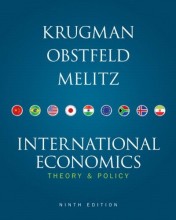Summary: Course Topics International Economics
- This + 400k other summaries
- A unique study and practice tool
- Never study anything twice again
- Get the grades you hope for
- 100% sure, 100% understanding
Read the summary and the most important questions on Course topics international economics
-
1 Classical models of trade
-
1.1 Introduction to international trade
This is a preview. There are 2 more flashcards available for chapter 1.1
Show more cards here -
What different trade streams characterize the history of trade?
- Post- neolithic period
- The first record of trade goes back to the assyrians
- The introduction of ships that were used to carry goods overseas
between Middle-east and India- Early modern period (age of discovery): Columbus that wanted to go to
India through a new route through Africa -
What three milestones in the history of trade can be identified?
1773 Boston Tea party: the patriots protested on the monopoly of tea, the tea was dumped in the sea
1840 Opium Wars: between China and Perzia, India´s main export was opium
1860 The first trade agreement: between UK and France on Wine and Fashion. It caused the trade to double between the two countries.
Before the 18th Century, trade made up less than 2% of a countries income -
Which two great waves of trade can be identified?
1) Late 1800- 1914: industrial revolution (1840); steamships, telegraph and railroads on steam, by WW1 trade determined 20% of the GDP, after that trade was blocked in a very short time
2) Post- war period: factors leading to an increase in trade:
- increases of transportation (tankers/containerization, jets, cell phone, fax) -
What was the result of the Bretton Woods conference
Countries became more economically linked, the worldbank and the IMF were created. Also the GATT was created. -
What is the difference in trade before 1900s and now?
Before 1900s trade was between sectors mainly, now the majority of trade is intra-industry (within a sector) -
1.2 The ricardian model: comparative advantage
This is a preview. There are 36 more flashcards available for chapter 1.2
Show more cards here -
What are the main reasons for the kind of export/import to certain countries?
1) Geographical
2) GDP
-
What characteristics help determining the trade partner?
- Distance
- Size (GDP)
- Tariffs/policies/currency
- Culture/language
- Resources/climate
-Technology
-
What is the gravity model?
Based on gravitational attraction law by Newton
alfa and beta are close to 1; there is a linear relation when distance proportional decreases
Determine the constant A to determine trade volume of the other countries
-
Why do countries engage in trade?
1. Differences in technology (specializing, Ricardian Model)
2. Differences in factors (H&O model)
3. Economies of scale; a greater output is better for one firm than for two
firms (models of monopolistic competition) -
What is the unit labor requirement?
How many units of labor are needed to produce one unit of output
There is an inverse relation between unit labor requirement and labour productivity
If you need 4 units of labour to produce 1 chair the unit labour requirement is 0.25
ac is unit labour requirement in the cheese sector
aw is unit labour requirement in the wine sector
- Higher grades + faster learning
- Never study anything twice
- 100% sure, 100% understanding






























